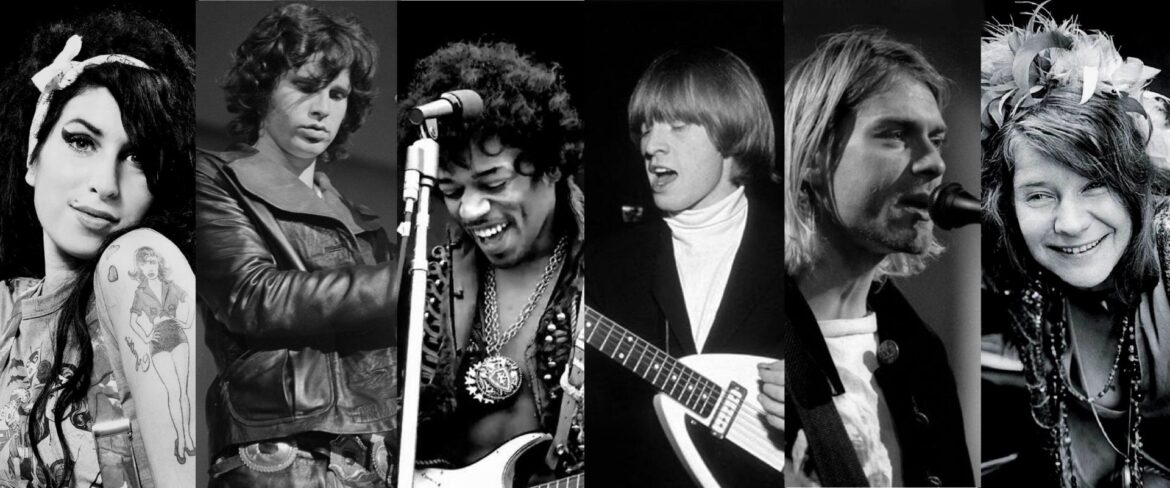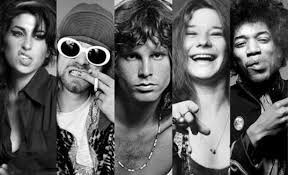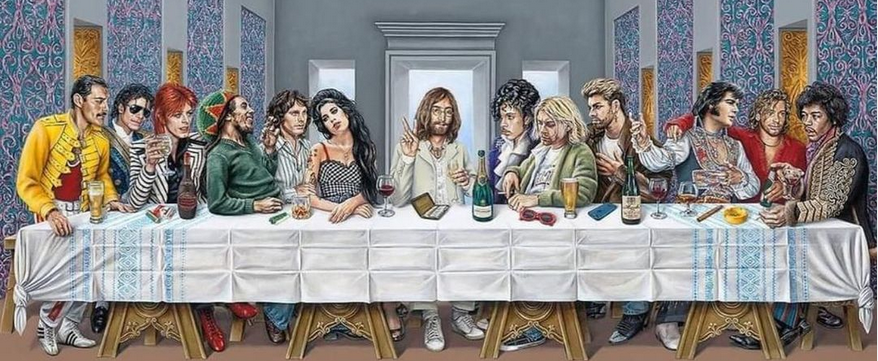
The “27 Club” is a cultural phenomenon referring to a group of popular musicians and entertainers who tragically died at the age of 27. The club is a reflection of the pressures, excesses, and vulnerabilities often faced by young artists in the entertainment industry.
Though it includes actors and artists, it is most famously associated with musicians whose lives were cut short during the prime of their careers. These deaths are often linked to drug or alcohol abuse, mental health struggles, and other self-destructive behaviors, though accidents and other causes also play a role. The “club” has grown to symbolize the darker side of fame, offering a haunting reminder of the fragility of life, particularly in high-stakes creative fields.
Origins of the 27 Club Phenomenon
The phenomenon gained mainstream recognition in the late 1960s and early 1970s, when several iconic musicians died at the age of 27 in quick succession. The first to become synonymous with this tragic group was Brian Jones, a founding member of the Rolling Stones. He was found dead in his swimming pool on July 3, 1969, under suspicious circumstances. His death was officially ruled “death by misadventure,” with heavy drug and alcohol use being contributing factors.
Shortly afterward, Jimi Hendrix and Janis Joplin, both revolutionary musicians in their own right, also died at 27. Hendrix, known for his groundbreaking guitar work and stage presence, died on September 18, 1970, due to an overdose of barbiturates. Less than a month later, on October 4, 1970, Joplin succumbed to a heroin overdose. The two, who had been at the forefront of the 1960s countercultural revolution, were followed by Jim Morrison, lead singer of The Doors. Morrison died in Paris on July 3, 1971, also at the age of 27, under circumstances that remain mysterious, though heart failure, likely linked to substance abuse, is often cited.
These four deaths created a collective narrative of young, prodigious musical talent dying too soon. With their intense lifestyles, countercultural appeal, and tragic ends, they became romanticized figures in popular culture. The fact that all these musicians were 27 when they died added an eerie, almost mystical quality to their legacies, marking the beginning of the 27 Club mythos.
Musicians in the 27 Club
Brian Jones (1942–1969)
Brian Jones was one of the original members of the Rolling Stones and instrumental in shaping the band’s early sound. As a multi-instrumentalist, Jones brought an experimental edge to the Stones’ music, incorporating instruments like the sitar and marimba into rock music. However, Jones became increasingly estranged from his bandmates due to his erratic behavior and drug problems. In 1969, shortly after being ousted from the band, Jones drowned in his swimming pool. His death is widely seen as the first in the line of tragic losses that would define the 27 Club.
Jimi Hendrix (1942–1970)
Jimi Hendrix is widely considered one of the greatest guitarists of all time. Known for his virtuosic skill, use of feedback and distortion, and innovative playing style, Hendrix left an indelible mark on rock music. Songs like “Purple Haze” and his rendition of “The Star-Spangled Banner” at Woodstock are iconic. Despite his public persona as a flamboyant rock god, Hendrix struggled with fame and the pressures of his career. His death from asphyxia, after taking a mix of alcohol and barbiturates, occurred in London in 1970, adding his name to the growing list of tragic rock legends.
Janis Joplin (1943–1970)
Janis Joplin was a pioneer of blues rock and one of the most powerful female vocalists of her era. Her raspy, soulful voice made songs like “Piece of My Heart” and “Cry Baby” unforgettable. Known for her raw energy and deeply emotional performances, Joplin also struggled with self-doubt and addiction. She died from a heroin overdose just weeks after Hendrix, cementing her place in rock’s tragic history. Joplin’s unique sound and uninhibited style remain influential, especially for female artists in rock and blues.
Jim Morrison (1943–1971)
Jim Morrison was the enigmatic frontman of The Doors, a band that combined rock, blues, and psychedelia. Known for his poetic lyrics, charismatic stage presence, and rebellious persona, Morrison embodied the countercultural spirit of the late 1960s. Songs like “Light My Fire” and “Riders on the Storm” showcased his dark, introspective lyrics and powerful voice. Morrison moved to Paris in 1971, seeking to escape the pressures of fame, but he was found dead in his apartment that July. Officially, he died of heart failure, but no autopsy was performed, leaving the exact cause of his death open to speculation.
Kurt Cobain (1967–1994)
The 1990s saw the revival of the 27 Club mythology with the death of Kurt Cobain, the frontman of the groundbreaking grunge band Nirvana. Cobain rose to fame in the early 1990s with the release of Nirvana’s album Nevermind, which featured the hit single “Smells Like Teen Spirit.” Cobain’s raw, anguished songwriting and his band’s distinctive blend of punk and metal resonated with a generation disillusioned by mainstream culture.
Despite his success, Cobain struggled with depression, addiction, and the pressures of fame. His suicide in April 1994, at the age of 27, revived the notion of a curse hanging over young musical geniuses. Cobain’s death was particularly tragic because it reflected many of the same issues that had plagued earlier members of the 27 Club—mental health struggles, substance abuse, and the alienation brought on by fame.
Amy Winehouse (1983–2011)
In 2011, Amy Winehouse, one of the most distinctive voices of her generation, died at 27, further solidifying the myth of the club. Known for her deep, soulful voice and blend of jazz, soul, and R&B, Winehouse gained international fame with her album Back to Black, featuring the hit “Rehab.” Her lyrics were deeply personal, often addressing her struggles with addiction, heartbreak, and mental health.
Despite her immense talent, Winehouse’s personal life was marred by addiction and destructive relationships. Her death from alcohol poisoning in 2011 brought renewed attention to the pressures and dangers that often accompany fame, especially for young artists.
.

.
Other Notable Members of the 27 Club
Robert Johnson (1911–1938)
Robert Johnson, often considered the first member of the 27 Club, was a blues musician whose influence on rock and blues is immeasurable. Johnson’s mysterious life and death have led to numerous legends, including the famous story that he sold his soul to the devil in exchange for his guitar skills. He died under unclear circumstances, possibly from poisoning, and his death contributed to the mythology that surrounds him. Johnson’s music, including songs like “Cross Road Blues” and “Sweet Home Chicago,” had a profound impact on future musicians like Eric Clapton and Keith Richards.
Alan “Blind Owl” Wilson (1943–1970)
Alan Wilson was the lead singer, guitarist, and primary songwriter for the blues band Canned Heat. He struggled with depression and a sense of alienation throughout his life. Wilson died from a drug overdose in September 1970, just weeks before Jimi Hendrix and Janis Joplin, further cementing the 27 Club narrative.
Ron “Pigpen” McKernan (1945–1973)
Ron McKernan, better known as Pigpen, was a founding member of the Grateful Dead. Unlike his bandmates, who were known for their use of psychedelics, McKernan preferred alcohol, which ultimately led to his decline. He died from gastrointestinal hemorrhage in 1973 at the age of 27.
Dave Alexander (1947–1975)
Dave Alexander was the original bassist for The Stooges, known for his role in shaping the aggressive, raw sound that defined punk rock in the 1970s. He died from pulmonary edema in 1975, attributed to his long-term alcohol abuse.
Pete Ham (1947–1975)
Pete Ham was the lead singer and guitarist of Badfinger, one of the first bands signed to The Beatles’ Apple Records. Financial struggles and legal battles pushed Ham into despair, and he tragically hanged himself in 1975 at the age of 27.
Chris Bell (1951–1978)
Chris Bell, a founding member of the influential power-pop band Big Star, died in a car crash in 1978. Bell struggled with depression, and his legacy is appreciated by musicians and fans alike, though he never achieved widespread fame during his lifetime.
D. Boon (1958–1985)
D. Boon was the lead singer and guitarist for the influential punk band Minutemen. Boon died in a car accident in 1985, cutting short a promising career in the punk scene.
Mia Zapata (1965–1993)
Mia Zapata, the lead singer of The Gits, was tragically murdered in 1993. Her death shocked the Seattle music scene and raised awareness of violence against women. She was 27 at the time of her death.
Kristen Pfaff (1967–1994)
Kristen Pfaff was the bassist for Hole, the band fronted by Courtney Love. Pfaff died from a heroin overdose in 1994, just months after Kurt Cobain’s death.
Richey Edwards (1967–1995, declared dead in 2008)
Richey Edwards, lyricist and rhythm guitarist for Manic Street Preachers, disappeared in 1995. Though his body was never found, he was declared legally dead in 2008, with his fate shrouded in mystery.
Conclusion
The 27 Club, while often mythologized, serves as a grim reminder of the challenges many young artists face. Whether due to addiction, mental health struggles, or other tragic circumstances, the lives of these musicians were cut short, robbing the world of their potential and creativity. While their music continues to inspire, their untimely deaths underscore the personal costs that often accompany fame and artistic genius.
Find out more about the 27 Club on Amazon.
.


Pingback: Robert Johnson died August 16, 1938. - Dead Musicians
Pingback: Musicians who were murdered - Dead Musicians